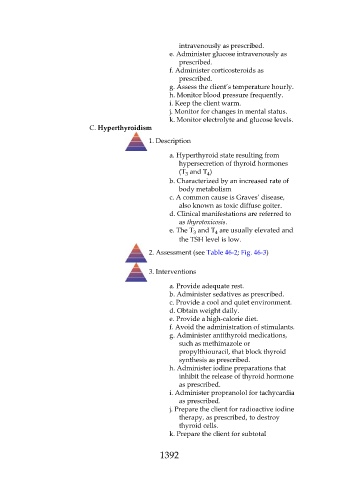Page 1392 - Saunders Comprehensive Review For NCLEX-RN
P. 1392
intravenously as prescribed.
e. Administer glucose intravenously as
prescribed.
f. Administer corticosteroids as
prescribed.
g. Assess the client’s temperature hourly.
h. Monitor blood pressure frequently.
i. Keep the client warm.
j. Monitor for changes in mental status.
k. Monitor electrolyte and glucose levels.
C. Hyperthyroidism
1. Description
a. Hyperthyroid state resulting from
hypersecretion of thyroid hormones
(T and T )
3
4
b. Characterized by an increased rate of
body metabolism
c. A common cause is Graves’ disease,
also known as toxic diffuse goiter.
d. Clinical manifestations are referred to
as thyrotoxicosis.
e. The T and T are usually elevated and
4
3
the TSH level is low.
2. Assessment (see Table 46-2; Fig. 46-3)
3. Interventions
a. Provide adequate rest.
b. Administer sedatives as prescribed.
c. Provide a cool and quiet environment.
d. Obtain weight daily.
e. Provide a high-calorie diet.
f. Avoid the administration of stimulants.
g. Administer antithyroid medications,
such as methimazole or
propylthiouracil, that block thyroid
synthesis as prescribed.
h. Administer iodine preparations that
inhibit the release of thyroid hormone
as prescribed.
i. Administer propranolol for tachycardia
as prescribed.
j. Prepare the client for radioactive iodine
therapy, as prescribed, to destroy
thyroid cells.
k. Prepare the client for subtotal
1392

